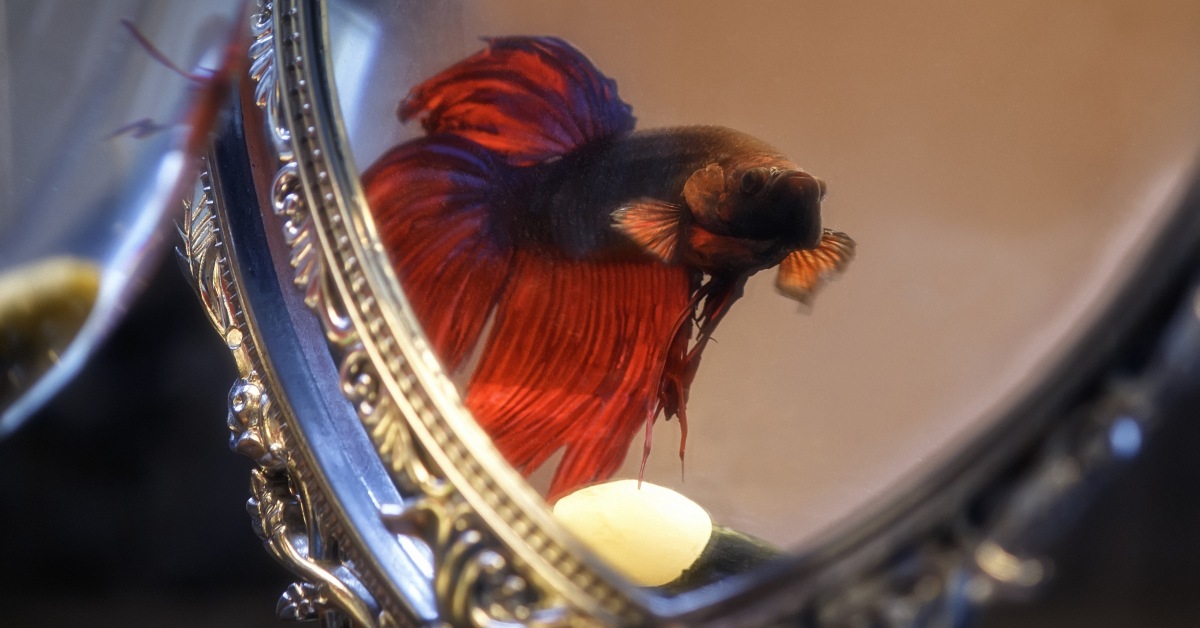A team of scientists has found that when cleaner fish were given parasite tattoos and a mirror was put in front of them, they tried to scrape them off – indicating these animals have mirror self-recognition (MSR).

What is self-awareness? Of course, it is a difficult to concept to comprehend but most scientists agree that being able to spot and identify your own reflection is evidence for self-awareness.
In 1970, evolutionary psychologist Gordon Gallup Jr. designed a test to find out which animals are capable of doing so. Since then, scientists have found that relatively few animals can pass the mirror test. Most humans can by age 18 to 24 months and so can chimps and orangutans, and many researchers say there’s also good evidence for dolphins, Asian elephants and European magpies also passing the test, even though Gallup himself is sceptical about those results.
The test involves animals being exposed to a mirror to find out whether they react in a way that indicates some recognition of themselves. For instance, do test subjects do unusual things to see if the image they see copies them? Do they tend to use the mirror to explore their own bodies? And when researchers show an animal in a place the creature can observe only in the mirror, does the animal try to remove it?

Back in 2019, Alex Jordan at the Max Planck Institute for Ornithology in Konstanz, Germany, and his team observed a reef-dwelling species called the cleaner wrasse (Labroides dimidiatus) doing unusual behaviors like swimming upside-down by the mirror. When fish were injected with a tag that left a visible brown mark under their throats, three of the four observed animals scraped that part of their bodies against a rock or the sandy bottom of the tank, in an attempt to remove it.
At that point, the researchers concluded that the fish had passed the test, but even Jordan himself was not convinced by the results, assuming his fish could have succeeded without possessing true self-awareness. Other scientists, including Gallup, have also criticized that study’s conclusions, suggesting they were flawed.
But in a new experiment, published in the journal PLOS Biology, Jordan and his team appears to have tackled these concerns by repeating the original experiment, this time using 18 animals. According to their findings, 17 of the 18 specimens (94 percent) exhibited the same MSR-induced cleaning behavior seen in the earlier experiment.

The parasite tattoos the scientists put on the fish were crucial to the first study as they created the optical illusion that there was something on the cleaner fish’s necks for them to remove and eat (as their name suggests, these fish love a good parasite). However, some criticized the methodology saying that the physical sensation of tattooing a fish could have been triggering the throat scratching rather than mirror recognition.
In the new study, however, the research team tackled this limitation by adding a new step to the process to test whether the fish would also respond to physical stimuli that weren’t visible. To do so, they gave fish the same parasite tattoo, but allowing it to go three times deeper into the skin – so that it wasn’t visible.
The scientists found that under these conditions, the cleaner fish would scratch their throats the same amount regardless whether or not there was a mirror present. So, to further establish the ecological context of a parasite being crucial to the MSR response, the scientists then gave fish visible tattoos that were green and blue and therefore didn’t resemble food.

In these conditions, none of the fish tried to scrape off these marks, indicating that the visual (rather than physical) perception of parasite-like marks was the likely explanation for the fish’s throat scratching behavior.
The cleaner fish’s lifestyle might partly explain why these animals appear to tackle the MSR experiments so effectively.
“Cleaner fish will pay attention to small parasites on other fish bodies and try to pick up and remove them,” study lead author Professor Masanori Kohda of Osaka City University told IFLScience.
“So, if we use a color mark resembling the parasite, the fish will show a good response to the mark. During the long 50-year history of mirror tests of animals, this study is the first test that uses the mark to which the subject animals pay attention. Hence, this fish shows the highest passing rate for mark-test, exceeding that of chimpanzees, dolphins, and elephants.”
Indeed a fascinating find, then, which appears to put fish consciousness into a completely new perspective. But while the new study does address some of the the criticisms of the past, even Prof. Kohda admits there is still a way to go.
“We still have much work to be done, especially quantitatively, to show that fish, as well as other animals, have the capacity for MSR,” Kohda concluded in a statement. “However, as a result of this study, we reiterate the conclusion of our previous study that either self-awareness in animals or the validity of the mirror test needs to be revised.”
